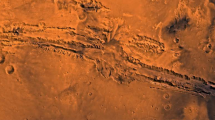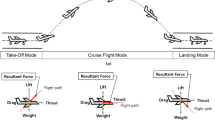Abstract
In this study, a rocket-based UAV and a solar wing-tail Martian UAV were designed and assessed against a set of criteria established using a house of quality chart. For the design, analysis, trade studies, and optimization, MATLAB and XFLR5 were used. The optimized versions of the two configurations feature the same wing and tail airfoils, the same wing and tail planforms, different dimensions, weight, and performance. Therefore, distinct types of scientific missions are suitable for these aircraft. The results of the study extend our understanding of the capabilities of a Martian fixed-wing airplane in terms of payload mass, hence its scientific value, as well as in terms of its planform geometry and airfoil shapes.





























Similar content being viewed by others
Data availability
All research data are available upon request.
References
Reed RD (1978) High-flying mini-sniffer
Gasbarre JF, Dillman RA (2003) Preliminary design and analysis of the ARES atmospheric flight vehicle thermal control system
NASA (2013) A concept study of a remotely piloted vehicle for mars exploration, NASA
Kearns J, Usui M, Smith SW, Scarborough SE, Smith T, Cadogan DP (2004) Development of UV-curable inflatable wings for low-density flight applications
Jacob JD, Lumpp JE, Smith SW, Smith WT (2006) Multidisciplinary design experience of a high altitude inflatable wing UAV for aerospace work force development
Benito J et al (2017) Hybrid propulsion mars ascent vehicle concept flight performance analysis. In: IEEE Aerospace Conference
Bar-Cohen Y, Colozza A, Badescu M, Sherrit S, Bao X (2012) biomimetic flying swarm of entomopters for mars extreme terrain science investigations
Colozza A, Miller C, Reed B, Kohout L, Loyselle P (2001) Overview of propulsion systems for a mars aircraft
Hanbing S, Underwood C (2007) A Mars VTOL Aerobot - preliminary design, dynamics and control. In: IEEE Aerospace Conference Proceedings, Guildford
Liu L, Cao X, Zhang X, He Y (2020) Review of development of light and small scale solar/hydrogen powered unmanned aerial vehicles. Acta Aeronaut Astronaut Sin 41(3):623
Appelbaum J, Landis GA, Sherman IR (1990) Solar radiation on Mars. Update 1991. Sol Energy 50:35–51
Forsythe WC, Rykiel EJ, Stahl RS, Wu H, Schoolfield RM (1995) A model comparison for daylength as a function of latitude and day of year. Ecol Model 80:87–95
Mars Climate Database v5.3 (2023) [Online]. Available: http://www-alternate-mars.lmd.jussieu.fr/mcd_python/
Noth A (2008) Design of solar powered airplanes for continuous flight. Url: [PDF] Design of solar powered airplanes for continuous flight. Semantic Scholar
INSIDEEVs (2023) [Online]. Available: https://insideevs.com/news/394309/oxis-cells-almost-500-wh-kg/
Ionel S (2023) High Energy Density Lithium Ion Cells with Silicon Nanowire Anode Technology, 26 08 2023. [Online]. Available: https://www1.grc.nasa.gov/wp-content/uploads/5.-Amprius.pdf
Dörfler S et al (2021) Recent progress and emerging application areas for lithium–sulfur battery technology. Energy Technol 9(1):2000694
Becтник HПO имeни C.A. Лaвoчкинa, №4, Mocквa, 2017, p 122
Mikhaylik YV, Kovalev I, Schock R, Kumaresan K, Xu J, Affinito J (2010) High energy rechargeable Li-S cells for EV application: status, remaining problems and solutions. ECS Trans 25(35):23–34
Rocket lab. [Online]. Available: https://www.rocketlabusa.com/space-systems/solar/space-solar-cellscics/. Accessed 27 Aug 2023
Drela M. "XFOIL". Available: https://web.mit.edu/drela/Public/web/xfoil/
Deperrois A. Available: http://www.xflr5.tech/docs/Results_vs_Prediction.pdf
Coder J, Maughmer M (2014) Comparisons of theoretical methods for predicting airfoil aerodynamic characteristics. J Aircr 51(1):183–191
Drela M (1989) XFOIL: an analysis and design system for low Reynolds numbers airfoils. Low Reynolds Number Aerodynamics, https://web.mit.edu/drela/Public/papers/xfoil_sv.pdf
Mcghee R, Jones G, Jouty R (1988) Performance characteristics from wind-tunnel tests of a low-Reynolds-number airfoil. AIAA, vol. 88, no. 6070
Lyon CA, Selig VS, Broeren AP (1997) Boundary layer trips on airfoils at low Reynolds numbers. In: 35th Aerospace Sciences Meeting & Exhibit, llinois
Johansson E (2018) Implications of designing unstable aircraft from a flight control perspective," http://www.diva-portal.org/smash/get/diva2:1380845/FULLTEXT01.pdf
Funding
This research was funded by the Russian Science Foundation, grant number 22–49-02047.
Author information
Authors and Affiliations
Corresponding author
Ethics declarations
Conflict of interest
The authors have no relevant financial or non-financial interests to disclose.
Rights and permissions
Springer Nature or its licensor (e.g. a society or other partner) holds exclusive rights to this article under a publishing agreement with the author(s) or other rightsholder(s); author self-archiving of the accepted manuscript version of this article is solely governed by the terms of such publishing agreement and applicable law.
About this article
Cite this article
Karpovich, E., Kombaev, T., Gueraiche, D. et al. Rocket-based versus solar wing-tail Martian UAVs: design, analysis, and trade studies. AS (2024). https://doi.org/10.1007/s42401-023-00267-w
Received:
Revised:
Accepted:
Published:
DOI: https://doi.org/10.1007/s42401-023-00267-w




